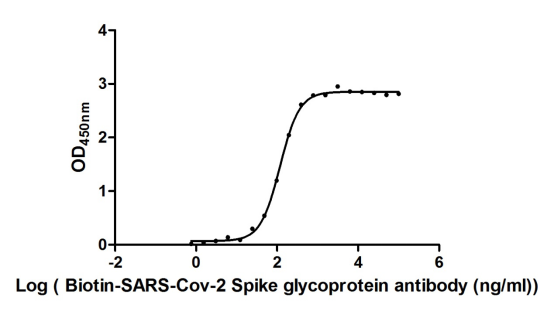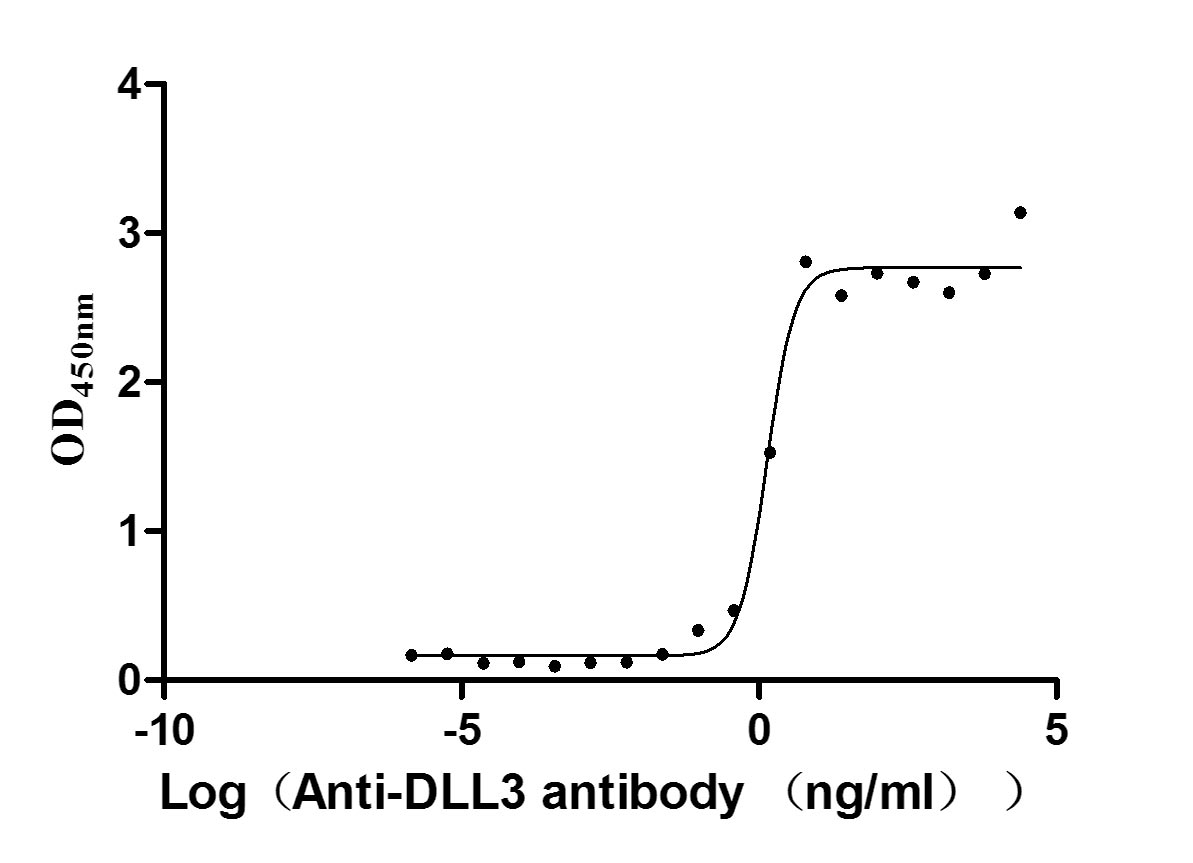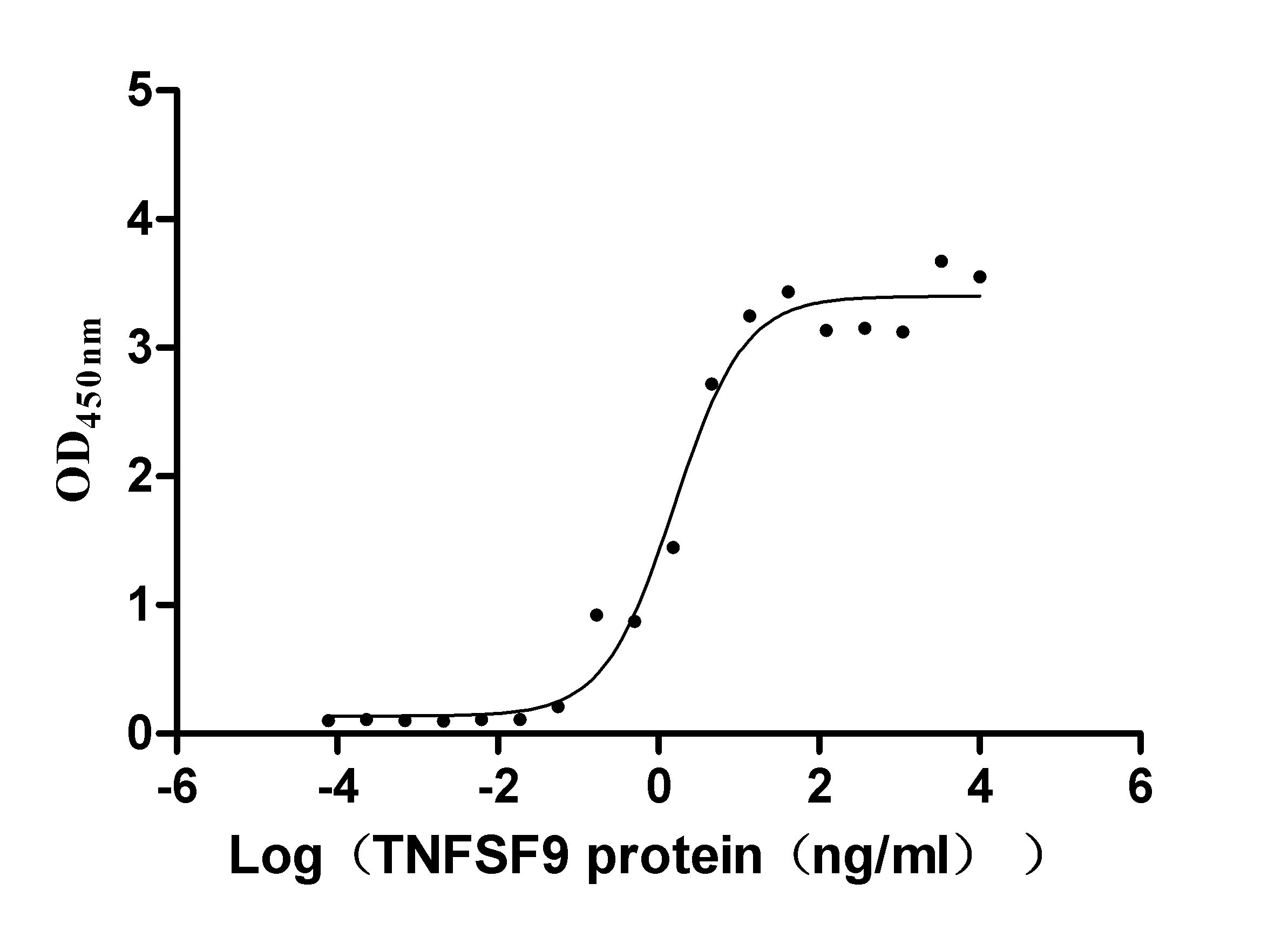Recombinant Human Phosphatidylinositol 4-phosphate 5-kinase type-1 gamma (PIP5K1C)
-
中文名称:人PIP5K1C重组蛋白
-
货号:CSB-YP018027HU
-
规格:
-
来源:Yeast
-
其他:
-
中文名称:人PIP5K1C重组蛋白
-
货号:CSB-EP018027HU
-
规格:
-
来源:E.coli
-
其他:
-
中文名称:人PIP5K1C重组蛋白
-
货号:CSB-EP018027HU-B
-
规格:
-
来源:E.coli
-
共轭:Avi-tag Biotinylated
E. coli biotin ligase (BirA) is highly specific in covalently attaching biotin to the 15 amino acid AviTag peptide. This recombinant protein was biotinylated in vivo by AviTag-BirA technology, which method is BriA catalyzes amide linkage between the biotin and the specific lysine of the AviTag.
-
其他:
-
中文名称:人PIP5K1C重组蛋白
-
货号:CSB-BP018027HU
-
规格:
-
来源:Baculovirus
-
其他:
-
中文名称:人PIP5K1C重组蛋白
-
货号:CSB-MP018027HU
-
规格:
-
来源:Mammalian cell
-
其他:
产品详情
-
纯度:>85% (SDS-PAGE)
-
基因名:
-
Uniprot No.:
-
别名:Diphosphoinositide kinase; LCCS3; Phosphatidylinositol-4-phosphate 5-kinase type I gamma; Phosphatidylinositol-4-phosphate 5-kinase type-1 gamma; PI51C; PI51C_HUMAN; PIP5K GAMMA; PIP5K1-gamma; Pip5k1c; PIP5KIgamma; PtdIns(4)P 5 kinase gamma; PtdIns(4)P-5-kinase 1 gamma; Type I PIP kinase
-
种属:Homo sapiens (Human)
-
蛋白长度:Full length protein
-
表达区域:1-668
-
氨基酸序列MELEVPDEAE SAEAGAVPSE AAWAAESGAA AGLAQKKAAP TEVLSMTAQP GPGHGKKLGH RGVDASGETT YKKTTSSTLK GAIQLGIGYT VGHLSSKPER DVLMQDFYVV ESIFFPSEGS NLTPAHHFQD FRFKTYAPVA FRYFRELFGI RPDDYLYSLC NEPLIELSNP GASGSLFYVT SDDEFIIKTV MHKEAEFLQK LLPGYYMNLN QNPRTLLPKF YGLYCVQSGG KNIRVVVMNN ILPRVVKMHL KFDLKGSTYK RRASKKEKEK SFPTYKDLDF MQDMPEGLLL DADTFSALVK TLQRDCLVLE SFKIMDYSLL LGVHNIDQHE RERQAQGAQS TSDEKRPVGQ KALYSTAMES IQGGAARGEA IESDDTMGGI PAVNGRGERL LLHIGIIDIL QSYRFIKKLE HTWKALVHDG DTVSVHRPSF YAERFFKFMS NTVFRKNSSL KSSPSKKGRG GALLAVKPLG PTAAFSASQI PSEREEAQYD LRGARSYPTL EDEGRPDLLP CTPPSFEEAT TASIATTLSS TSLSIPERSP SETSEQPRYR RRTQSSGQDG RPQEEPPAEE DLQQITVQVE PACSVEIVVP KEEDAGVEAS PAGASAAVEV ETASQASDEE GAPASQASDE EDAPATDIYF PTDERSWVYS PLHYSAQAPP ASDGESDT
-
蛋白标签:Tag type will be determined during the manufacturing process.
The tag type will be determined during production process. If you have specified tag type, please tell us and we will develop the specified tag preferentially. -
产品提供形式:Lyophilized powder
Note: We will preferentially ship the format that we have in stock, however, if you have any special requirement for the format, please remark your requirement when placing the order, we will prepare according to your demand. -
复溶:We recommend that this vial be briefly centrifuged prior to opening to bring the contents to the bottom. Please reconstitute protein in deionized sterile water to a concentration of 0.1-1.0 mg/mL.We recommend to add 5-50% of glycerol (final concentration) and aliquot for long-term storage at -20℃/-80℃. Our default final concentration of glycerol is 50%. Customers could use it as reference.
-
储存条件:Store at -20°C/-80°C upon receipt, aliquoting is necessary for mutiple use. Avoid repeated freeze-thaw cycles.
-
保质期:The shelf life is related to many factors, storage state, buffer ingredients, storage temperature and the stability of the protein itself.
Generally, the shelf life of liquid form is 6 months at -20°C/-80°C. The shelf life of lyophilized form is 12 months at -20°C/-80°C. -
货期:Delivery time may differ from different purchasing way or location, please kindly consult your local distributors for specific delivery time.Note: All of our proteins are default shipped with normal blue ice packs, if you request to ship with dry ice, please communicate with us in advance and extra fees will be charged.
-
注意事项:Repeated freezing and thawing is not recommended. Store working aliquots at 4°C for up to one week.
-
Datasheet :Please contact us to get it.
相关产品
靶点详情
-
功能:Catalyzes the phosphorylation of phosphatidylinositol 4-phosphate (PtdIns(4)P/PI4P) to form phosphatidylinositol 4,5-bisphosphate (PtdIns(4,5)P2/PIP2), a lipid second messenger that regulates several cellular processes such as signal transduction, vesicle trafficking, actin cytoskeleton dynamics, cell adhesion, and cell motility. PtdIns(4,5)P2 can directly act as a second messenger or can be utilized as a precursor to generate other second messengers: inositol 1,4,5-trisphosphate (IP3), diacylglycerol (DAG) or phosphatidylinositol-3,4,5-trisphosphate (PtdIns(3,4,5)P3/PIP3) (Probable). PIP5K1A-mediated phosphorylation of PtdIns(4)P is the predominant pathway for PtdIns(4,5)P2 synthesis. Together with PIP5K1A, is required for phagocytosis, both enzymes regulating different types of actin remodeling at sequential steps. Promotes particle attachment by generating the pool of PtdIns(4,5)P2 that induces controlled actin depolymerization to facilitate Fc-gamma-R clustering. Mediates RAC1-dependent reorganization of actin filaments. Required for synaptic vesicle transport. Controls the plasma membrane pool of PtdIns(4,5)P2 implicated in synaptic vesicle endocytosis and exocytosis. Plays a role in endocytosis mediated by clathrin and AP-2 (adaptor protein complex 2). Required for clathrin-coated pits assembly at the synapse. Participates in cell junction assembly. Modulates adherens junctions formation by facilitating CDH1/cadherin trafficking. Required for focal adhesion dynamics. Modulates the targeting of talins (TLN1 and TLN2) to the plasma membrane and their efficient assembly into focal adhesions. Regulates the interaction between talins (TLN1 and TLN2) and beta-integrins. Required for uropodium formation and retraction of the cell rear during directed migration. Has a role in growth factor-stimulated directional cell migration and adhesion. Required for talin assembly into nascent adhesions forming at the leading edge toward the direction of the growth factor. Negative regulator of T-cell activation and adhesion. Negatively regulates integrin alpha-L/beta-2 (LFA-1) polarization and adhesion induced by T-cell receptor. Together with PIP5K1A has a role during embryogenesis and together with PIP5K1B may have a role immediately after birth.
-
基因功能参考文献:
- The Btk-dependent PIP5K1gamma lipid kinase activation by Fas counteracts FasL-induced cell death. PMID: 28879546
- High expression of PIP5K1-gamma is associated with colorectal cancer. PMID: 28560454
- These data reveal a novel function for PKD1 as a regulator of focal adhesion dynamics and by identifying PIP5Klgamma as a novel PKD1 substrate provide mechanistic insight into this process. PMID: 27775029
- PIPKIgamma promotes the transcription of the PD-L1 gene by activating the NF-kappaB pathway in these cells. These results demonstrate that PIPKIgamma-dependent expression of PD-L1 is likely important for the progression of triple negative breast cancer. PMID: 28465490
- FAK sustained the active integrin conformation by maintaining talin association with Rab11 endosomes in a type I phosphatidylinositol phosphate kinase (PIPKIgamma)-dependent manner. PMID: 27043085
- These data suggest that S6K1-mediated PIPKIgamma90 phosphorylation regulates cell migration and invasion by controlling PIPKIgamma90 degradation. PMID: 27780861
- PIPKIgammai5, NEDD4-1, and Mig6 form a novel molecular nexus that controls EGFR activation and downstream signaling. PMID: 27557663
- PIPKIgamma and INPP5E localize to the centrosome and coordinate the initiation of ciliogenesis. PMID: 26916822
- results suggested that Akt-mediated PIP5Kgamma90 S555 phosphorylation is a novel regulatory point for talin binding to control PIP2 level at the FAs, thereby modulating FA dynamics and cell motility. PMID: 26149501
- Loss of PIPKIgamma or its focal adhesion-targeting variant, PIPKIgammai2, impaired PI3K/Akt activation upon stimulation with growth factors or extracellular matrix proteins in different tumor cells. PMID: 26070568
- PIPKIgamma binds to the cryptic polo-box domain of PLK4 and reduces the kinase activity of PLK4. PMID: 24434581
- This study uncovers a novel mechanism where a phosphoinositide-synthesizing enzyme, PIPKIgammai2, functions with the proto-oncogene Src, to regulate oncogenic signaling PMID: 24151076
- PIPKIgamma positively regulates focal adhesion dynamics and cancer invasion, most probably through PIP-mediated vinculin activation. PMID: 21931851
- EZH2 regulates neuronal differentiation of mesenchymal stem cells through PIP5K1C-dependent calcium signaling. PMID: 21216957
- A novel mechanism in which PIPKIgamma expression and catalytic activity enhance beta-catenin nuclear translocation and expression of its target genes to promote tumorigenic phenotypes. PMID: 21303971
- SIRT1 deacetylated two specific lysine residues (K265/K268) in PIP5Kgamma and enhanced PIP5Kgamma enzyme activity. PMID: 20668706
- Data show that glycation end products (AGE) increase PIP2 production, arachidonic acid release and reactive oxygen species via cytosolic phospholipase A2 activation, and inhibit Na+ K+ ATPase surface expression via PIP5Kgamma. PMID: 20435073
- This publication discusses the initial identification of human phosphatidylinositol-4-phosphate 5-kinase type-1 gamma (AB011161, KIAA0589). PMID: 9628581
- This publication discusses cloning of mouse phosphatidylinositol-4-phosphate 5-kinase type-1 gamma. PMID: 9535851
- Type I gamma phosphatidylinositol phosphate kinase modulates invasion and proliferation and its expression correlates with poor prognosis in breast cancer. PMID: 20074374
- multiple interactions between PIPKI gamma-p90 and AP-2 lead to spatiotemporally controlled PI(4,5)P(2) synthesis during clathrin-mediated synaptic vesicle endocytosis PMID: 19903820
- we show that the predominant brain splice variant of PtdInsPKI gamma (PtdInsPKI gamma-90) binds, by means of a short carboxy-terminal peptide, to the FERM domain of talin, and is strongly activated by this interaction PMID: 12422219
- we show that the type I phosphatidylinositol phosphate kinase isoform-gamma 661 (PIPKI gamma 661), an enzyme that makes PtdIns(4,5)P(2), is targeted to focal adhesions by an association with talin PMID: 12422220
- The short splice variant of type I phosphatidylinositol 4-phosphate 5-kinase gamma (PIP5KIgamma87) as the major contributor of the PIP(2) pool that supports G protein-coupled receptor (GPCR)-mediated IP(3) generation. PMID: 15611330
- PIPKIgamma661 enzyme is involved in the AP2-mediated endocytosis of transferrin. PMID: 16707488
- a positive feedback loop consisting of endocytic cargo proteins, AP-2mu, and PIPK type I which may provide a specific pool of PI(4,5)P(2) dedicated to clathrin/AP-2-dependent receptor internalization PMID: 16880396
- Localization of ezrin in adherens junctions is regulated by Rac in a manner involving PIPK. PMID: 17229424
- results reveal a novel mechanism where PIPKIgamma serves as a scaffold, linking E-cadherin to adaptor complexes and the trafficking machinery, and a regulator of trafficking events via the spatial generation of phosphatidylinositol-4,5-bisphosphate PMID: 17261850
- PIP5K1C is required for EGF-stimulated diectional cell migration. PMID: 17635937
- A single homozygous substitution of aspartic acid with asparagine at amino acid 253 in PIP5K1C causes lethal contractural syndrome type 3> PMID: 17701898
- identify a previously unknown function for PIPKIgamma661 as a novel component of the backness signal that regulates rear retraction during chemotaxis PMID: 17928408
- Type I phosphatidylinositol-4-phosphate-5-kinase (PI5KI) alpha and gamma isoforms were identified as the enzymes responsible for PIP2 synthesis in natural killer cells. PMID: 18073347
- Data have identified two novel C-terminal splice variants of PIPKIgamma that are expressed in multiple tissue types, display PIPK activity in vitro abd have distinct subcellular targeting. PMID: 19548880
显示更多
收起更多
-
相关疾病:Lethal congenital contracture syndrome 3 (LCCS3)
-
亚细胞定位:Cell membrane; Peripheral membrane protein; Cytoplasmic side. Endomembrane system. Cytoplasm. Cell junction, focal adhesion. Cell junction, adherens junction. Cell projection, ruffle membrane. Cell projection, phagocytic cup. Cell projection, uropodium. Note=Detected in plasma membrane invaginations. Isoform 3 is detected in intracellular vesicle-like structures.; [Isoform 2]: Cytoplasm. Nucleus.
-
组织特异性:[Isoform 1]: Isoform 1 is strongly expressed in brain and also detected in heart and lung.; [Isoform 2]: Isoform 2 is strongly expressed in pancreas and liver and in lesser quantities in brain, heart, lung and kidney.; [Isoform 3]: Isoform 3 is detected i
-
数据库链接:
HGNC: 8996
OMIM: 606102
KEGG: hsa:23396
STRING: 9606.ENSP00000335333
UniGene: Hs.282177
Most popular with customers
-
Recombinant Severe acute respiratory syndrome coronavirus 2 Spike glycoprotein (S), partial (Active)
Express system: Mammalian cell
Species: Severe acute respiratory syndrome coronavirus 2 (2019-nCoV) (SARS-CoV-2)
-
Recombinant Human Delta-like protein 3 (DLL3), partial (Active)
Express system: Mammalian cell
Species: Homo sapiens (Human)
-
Recombinant Human Tumor necrosis factor receptor superfamily member 9 (TNFRSF9), partial (Active)
Express system: Mammalian cell
Species: Homo sapiens (Human)
-
Recombinant Human Claudin-18.2 (CLDN18.2)-VLPs (Active)
Express system: Mammalian cell
Species: Homo sapiens (Human)
-
Recombinant Dog B-lymphocyte antigen CD20 (MS4A1)-VLPs (Active)
Express system: Mammalian cell
Species: Canis lupus familiaris (Dog) (Canis familiaris)
-
Recombinant Human Microtubule-associated protein tau (MAPT) (Active)
Express system: Mammalian cell
Species: Homo sapiens (Human)
-
Recombinant Human Alkaline phosphatase, germ cell type (ALPG) (Active)
Express system: Mammalian cell
Species: Homo sapiens (Human)
-
Recombinant Human Cytotoxic and regulatory T-cell molecule (CRTAM), partial (Active)
Express system: Mammalian cell
Species: Homo sapiens (Human)





-AC1.jpg)

-AC1.jpg)












